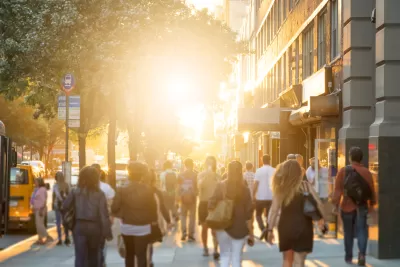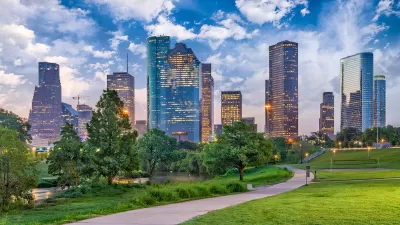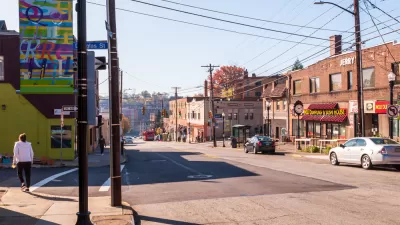A recent article tries to tie public transit and walkability to social disorder — but in fact, sprawling Sunbelt cities like Memphis are as likely to have high crime rates as transit-rich metropolises such as New York and San Francisco.

A month ago, the Federalist (an online newspaper that generally supports the MAGA wing of the Republican Party) ran an article entitled: “New Urbanists Want To Bulldoze the Suburban American Dream.” The thesis of the article seems to be: sprawl good, anything else bad and un-conservative. Numerous commentators have already criticized this article from a pro-free market perspective, pointing out that car-dependent suburban sprawl is a product not of consumers’ free-market wishes, but of bureaucratic overregulation. (See for example these posts by Andy Boenau, Sam Sklar, and the Congress for New Urbanism; some years ago, I have made similar points in my own scholarship).
But the article also has some claims unrelated to economics, which I think are also worth debunking. The article tries to tie urbanism to crime and social disorder, stating: “the cities that New Urbanists idolize, such as New York, San Francisco, and Chicago, are collapsing under the weight of crime, homelessness, and deteriorating infrastructure. Instead of addressing these failures, urban planners double down on the same policies that created the problems: more density, fewer cars, and an obsession with “public spaces” that inevitably become magnets for vagrancy and disorder.”
These sentences seem to make two factual claims: 1) New York, San Francisco, and Chicago are uniquely disorderly; and 2) “more density [and] fewer cars” are somehow the cause of this.
The first claim is obviously false, because these cities are less dangerous than many less dense cities. The americanviolence.org website lists 2023 murder rates for 36 cities with over 500,000 people. The most dense, transit-oriented city in the United States, New York had 4.3 murders per 100,000 residents, lower than all but two other large cities (San Diego and San Jose). San Francisco had 6.1 per 100,000, lower than all but eight of the 35 other cities with over 500,000 residents. Chicago, by contrast, was more dangerous than average (with 22.7 homicides per 100,000)- but even so, seven cities in this group had higher homicide rates than Chicago.
The most homicidal large city, Memphis, is extremely sprawling and car-dependent. Memphis has only 2223 people per square mile, less than one-fifth the density of Chicago, less than one-seventh the density of San Francisco, and less than one-tenth the density of New York. According to the 2023 American Community Survey, only 3 percent of Memphis residents walked, took a bus, or biked to work — less than one-eighth the percentage of Chicago residents, one-eleventh the percentage of San Francisco residents, and one-eighteenth the percentage of New York residents. Yet Memphis had over 50 homicides per 100,000 residents. Similarly, my hometown of Atlanta has just under 3700 residents per square mile (less than one-seventh the density of New York) and had a higher murder rate than Chicago.
Moreover, these cities generally got safer as they became more populous and thus denser. New York City’s population grew from 8 million to 8.8 million throughout the 2000s and 2010s, and its crime rates nosedived: between 2000 and 2019, the number of murders nosedived from 673 to 318. In San Francisco, the population also grew from 777,000 to just over 870,000 during these decades, the number of murders during this period declined from 59 to 41. (Chicago didn’t really grow during these decades, so it isn’t really relevant to this part of my argument). By contrast, when these cities became less populous and therefore less dense during COVID, crime rose. (I am not saying that density reduced crime: I suspect that lower crime leads to more population and that higher crime leads to less population).
Is homelessness worse in the most walkable cities? The Brookings Institution ranked 48 cities by levels of sheltered and unsheltered homelessness. San Francisco was number one, but Chicago and New York were actually below average. Chicago ranked number 27, with 47 unsheltered homeless people per 100,000 residents — less than one-eleventh the rate of San Francisco, and below sprawl-heavy cities like Oklahoma City and Kansas City. New York ranked 28th, much to my surprise. (New York has a high overall homeless rate, but also has a larger homeless shelter system than most cities).
The article does make one point that is slightly more sophisticated: they point out that cars "enable families to escape crime-ridden cities..." This clause is not as detached from factual reality as the rest of the article: it is true that outer suburbs often have low crime rates. But as a metro area sprawls, crime sprawls with it: disinvestment and decay may begin near downtown, but as more and more further-out areas become deserted by well-off families, those areas become crime-ridden as well. For example, Clayton County near Atlanta had 41 homicides (or just over 13 per 100,000 residents)- three times the homicide rate of New York City. So when government invests in sprawl by building new highways, it ensures that both "good" and "bad" neighborhoods are further out than they would otherwise be.
In sum, the article’s attempt to tie social disorder to density and walkability is just silly- first because sprawling cities like Atlanta and Memphis are often as crime-ridden as more compact cities, and second because there is at least some evidence that cities became safer as they become more compact.
*Chicago was in between, with shootings in about 60 percent of its tracts. Because I couldn't find out how many census tracts there are in San Francisco I can't figure out how San Francisco compares.

Trump Administration Could Effectively End Housing Voucher Program
Federal officials are eyeing major cuts to the Section 8 program that helps millions of low-income households pay rent.

Planetizen Federal Action Tracker
A weekly monitor of how Trump’s orders and actions are impacting planners and planning in America.

Ken Jennings Launches Transit Web Series
The Jeopardy champ wants you to ride public transit.

Washington Legislature Passes Rent Increase Cap
A bill that caps rent increases at 7 percent plus inflation is headed to the governor’s desk.

From Planning to Action: How LA County Is Rethinking Climate Resilience
Chief Sustainability Officer Rita Kampalath outlines the County’s shift from planning to implementation in its climate resilience efforts, emphasizing cross-departmental coordination, updated recovery strategies, and the need for flexible funding.

New Mexico Aging Department Commits to Helping Seniors Age ‘In Place’ and ‘Autonomously’ in New Draft Plan
As New Mexico’s population of seniors continues to grow, the state’s aging department is proposing expanded initiatives to help seniors maintain their autonomy while also supporting family caregivers.
Urban Design for Planners 1: Software Tools
This six-course series explores essential urban design concepts using open source software and equips planners with the tools they need to participate fully in the urban design process.
Planning for Universal Design
Learn the tools for implementing Universal Design in planning regulations.
Heyer Gruel & Associates PA
Ada County Highway District
Institute for Housing and Urban Development Studies (IHS)
City of Grandview
Harvard GSD Executive Education
Toledo-Lucas County Plan Commissions
Salt Lake City
NYU Wagner Graduate School of Public Service





























